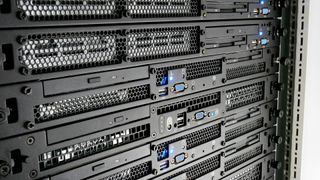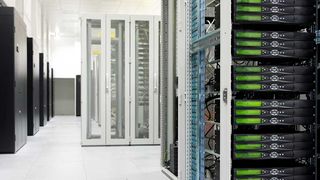Bare metal vs dedicated servers: which is the better option?
In comparing bare metal vs dedicated servers, our detailed guide explains the differences between the two.

If, when choosing the best web hosting services that offer dedicated servers, you’re trying to get the best performance out of yours, you have to choose between two options: bare metal vs dedicated servers.
Specifically speaking, these are respectively traditional dedicated servers and modern bare metal options. However, what’s the best way to choose, and what elements or factors should you base your choice on? Here, we’ve aimed to clarify the difference between the two, touching on a few common industry myths as we go.
Bare metal vs dedicated servers: Aren’t they the same?

Technically speaking, there’s a lot of similarities between bare metal and dedicated servers. For example, they're both physical machines, rather than virtualised servers composed of a collection of resources. In actual fact, the ‘bare metal’ name originates from the absence of any virtualisation or a hypervisor layer.
Basically, bare metal servers provide full access to the machine’s hardware, allowing you to configure things as required. Both dedicated and bare metal servers only host one client at a time. In short, this means that you will have full access to your processor, storage, and memory without having to worry about it being impacted by other users.
Dedicated hosting
With both options, you, and only you will be able to draw on your machine’s power, and your performance won’t ever be affected by other users. Now, understand that both traditional and bare metal servers offer a form of dedicated hosting. When compared side-by-side, bare metal servers tend to have more advanced hardware than their traditional alternatives. Usually, they include the latest in computing technology, such as Intel Xeon CPUs and DDR4 RAM.
Similarly, bare metal servers tend to use the best in storage technology, often featuring NVMe SSD storage that’s miles ahead of traditional HDD and SATA SSD storage options. Connectivity is another major consideration, and both options are equally capable here with high-speed connections up to 1GB per second.
The chances are that if you’re looking for a high-quality server that will deliver maximum performance, you already know exactly what you’re going to use it for. The performance of dedicated physical servers (both traditional options and bare metal servers) is unbeatable, which means that they are often the only viable choice for high-traffic sites, complex portals, and specific applications such as video rendering, VoIP, online gaming, SaaS, and more.
Get the ITPro. daily newsletter
Receive our latest news, industry updates, featured resources and more. Sign up today to receive our FREE report on AI cyber crime & security - newly updated for 2024.
Use with ecommerce and CMSs
On top of this, all dedicated servers can handle extremely high visitor numbers, transaction processing, and more when using an enterprise-level ecommerce CMS (such as Magento or WooCommerce). Similarly, they can be configured to provide extremely low latency for online gaming and other applications where speed is a priority. And compared to shared hosting, which can be unreliable at times, you can rest assured that you will always have full access to the hardware resources that you’ve paid for.
Finally, traditional and bare metal dedicated servers offer unparalleled web security and control. There’s little to differentiate the two here, as both options allow you to select an operating system, install server-wide applications, and deploy your own hypervisors. You will also have full root access so you can customise the hosting experience as required.
Time is money

The primary difference between traditional and bare metal dedicated servers is their price structures. In general, bare metal servers offer the same or better performance than traditional alternatives, and are billed using a flexible, hourly-billed model.
With a traditional server, you will usually have to pay for a monthly or yearly contract, while a bare metal server can be run for as long or as short a time as you want without being locked into any contract. This means that they are a great choice for sites or apps that experience traffic spikes at specific times—for example, during sales or on certain holidays.
As you’re probably beginning to realise, bare metal and traditional dedicated servers are therefore designed for different use cases. The traditional option is designed to be used over the long-term, while bare metal servers are a great choice for situations where such a high level of performance is only required for a short time.
In general, it’s possible to integrate both types of dedicated server with other types of hosting. For example, many companies host their main website on a cloud or VPS server, re-routing traffic through a dedicated server when their main hosting can’t handle it. Similarly, many applications are first tested on virtual machines without the need for high-end performance specs before being transferred to a dedicated server.
In these and other similar cases, bare metal servers are almost always the best option. Since they are designed both to operate individually and as nodes in a larger network of servers, they come with additional tools to make configuration and network linking that much easier. It’s extremely easy to connect dedicated bare metal hardware with VPS hosting or VMs, and management is often possible through a single cloud-based control panel.
And what’s more, things have advanced significantly when it comes to deployment of dedicated servers. In the past, they were manually provisioned, which often took some time. Nowadays, most providers use automated provisioning, allowing you to get online much faster and with significantly fewer delays.
What are you building?
In general, traditional and bare metal dedicated servers are much more similar than they are different. Neither option is clearly better than the other in all situations, which means you should make your choice based on your needs and deployment goals.
Overall, the things you’re planning to use your server for and your overall budget will largely dictate which option you go for. In most cases, bare metal servers are the best option for running alongside other hosting services. They can be integrated together using any one of a range of tools.
Finally, you should always go for a bare metal server if you need top-of-the-range hardware. They usually come with the absolute latest and greatest technology, with the best memory, storage, CPU, control, and connectivity possible. If you need the fastest, most flexible, and most powerful hosting option possible, go for a bare metal server.
Further reading on web hosting and website builders
Once you've found the best website builder, and are looking for cheaper hosting, look into the best cheap web hosting for your next project, or even the best free web hosting if you're on a tight budget. If you're searching for hosting for a small business website, take a look at the best web hosting for small business.
Do you want your site to focus on European and UK customers? Ensure your chosen host is among the best European web hosting providers. Finally, if you've got a WordPress website or are looking to create one with one of the best WordPress website builders, the best WordPress hosting is ideal and is provided by many of the best web hosts.
Daniel is a freelance technology and finance writer, whose scientific background in the natural sciences lends rigour and nuance to his informative, accessible articles. His reviews on website builders, web hosting and business web development grace the virtual pages of TechRadar Pro, WebsiteHostingRating.com, and HostingReview.com, as well as IT Pro Portal. Well-versed in blockchain, cloud computing and cybersecurity, Daniel takes a keen interest in all aspects of B2B and B2C tech.





